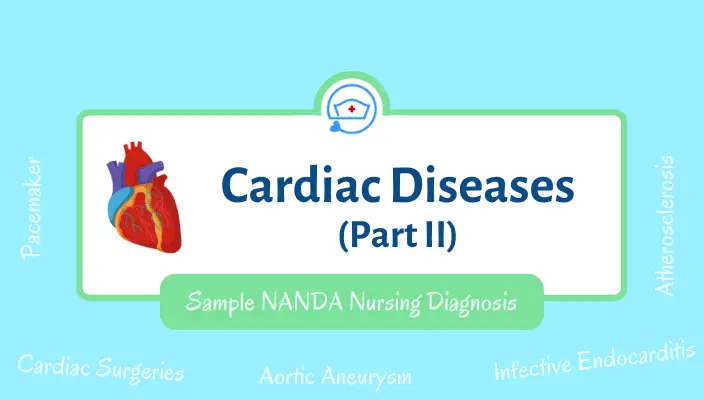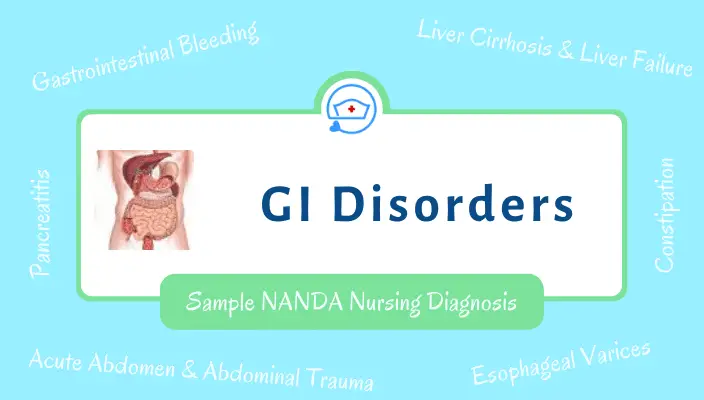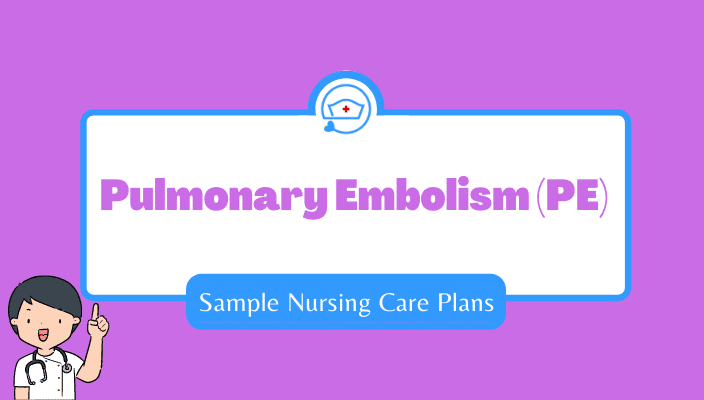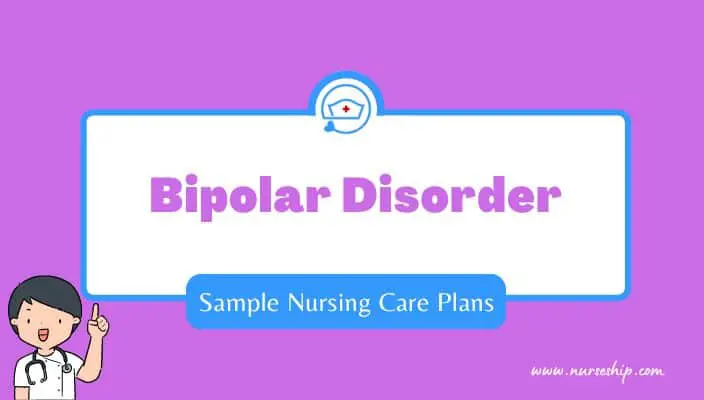This is part 2 of NANDA nursing diagnoses for various disease conditions of the Cardiovascular System. Use the table of contents to jump the part you need.
Click here to see Part 1 of this series.
NANDA Nursing Diagnosis for Pacemaker
Risk for ineffective peripheral tissue perfusion
Ineffective peripheral tissue perfusion
Risk for decreased cardiac tissue perfusion
Risk for ineffective cerebral tissue perfusion
May be related to: cardiac dysrhythmias, heart blocks, tachydysrhythmias, decreased blood pressure, decreased cardiac output.
As evidenced by: decreased blood pressure, decreased heart rate, decreased cardiac output, changes in level of consciousness, mental status changes, cold clammy skin, cardiopulmonary arrest.
Impaired skin integrity
May be related to: insertion of temporary or permanent pacemaker, changes in mobility.
As evidenced by: disruption of skin tissue, insertion site.
Acute Pain
May be related to: pacemaker insertion or transcutaneous pacing
As evidenced by: Verbal report of pain, facial grimacing, restlessness, changes in pulse and blood pressure.
Risk for injury
May be related to: pacemaker failure, hemothorax or pneumothorax after insertion, bleeding, lead migration, heart perforation.
As evidenced by: decreased cardiac output, hemorrhage, diaphoresis, hypotension, restlessness, dyspnea, cyanosis, chest pain, muscle twitching, hiccoughs, muffled heart sounds, jugular vein distention, pulsus paradoxus.
Impaired physical mobility
May be related to: pain, limb immobilization.
As evidenced by: inability to move as desired, imposed restrictions on activity, decreased muscle strength and coordination, limited range of motion.
Disturbed body image
May be related to: presence of pulse generator, loss of control of heart function, disease process.
As evidenced by: fear of rejection, fear of reaction from others, negative feelings about the body, refusal to participate in care, refusal to look at the wound.
Activity intolerance
May be related to: generalized weakness, imbalance between oxygen supply and demand.
As evidenced by: Verbalization of fatigue or weakness, abnormal heart rate or BP in response to activity, exertional discomfort, shortness of breath, dyspnea.
Ineffective coping
May be related to: Situational crisis, multiple life changes, inadequate relaxation, inadequate support systems, unmet expectations, unrealistic perceptions, ineffective coping methods, gender differences in coping strategies.
As evidenced by: Verbalization of inability to cope or ask for help, inability to meet role expectations or basic needs, destructive behavior toward self, insomnia, muscular tension, irritability, anxiety, emotional tension, depression.
Anxiety
May be related to: change in health status, fear of death, threat to body image, threat to role functioning, pain.
As evidenced by: restlessness, insomnia, anorexia, increased respiration, increased heart rate, increased blood pressure, difficulty concentrating, dry mouth, poor eye contact, decreased energy, irritability, crying, feelings of helplessness.
Knowledge deficit
May be related to: lack of understanding, lack of understanding of medical condition, lack of recall
As evidenced by: questions regarding problems, inadequate follow-up on instructions given, misconceptions, lack of improvement of the previous regimen, development of preventable complications.
Click here to see Part 1 of this series
NANDA Nursing Diagnosis for Atherosclerosis
Chronic Pain
May be related to: reduced circulation and ischemia
As evidenced by: intermittent claudication, delayed wound healing, gangrene.
Ineffective peripheral tissue perfusion
Risk for ineffective peripheral tissue perfusion
May be related to: decreased arterial flow occurring with atherosclerosis; acute occlusion occurring with a postsurgical graft embolus.
As evidenced by: decreased sensory or motor function, pallor or dependent rubor, audible bruits, cool, pale or bluish discoloration of the extremities.
Impaired skin integrity
Risk for impaired skin integrity
May be related to: altered arterial circulation occurring with atherosclerotic process
As evidenced by: decreased sensory or motor function, leg or foot ulcers, pallor or dependent rubor, cool, pale or bluish discoloration of the extremities.
Deficient Knowledge
May be related to: unfamiliarity with the potential for infection and impaired tissue integrity caused by decreased arterial circulation
As evidenced by: questions regarding problems, inadequate follow-up on instructions given, misconceptions, development of preventable complications.
Anxiety
May be related to: change in health status, fear of death, threat to body image, threat to role functioning, pain.
As evidenced by: restlessness, insomnia, anorexia, increased respiration, increased heart rate, increased blood pressure, difficulty concentrating, dry mouth, poor eye contact, decreased energy, irritability, crying, feelings of helplessness.
Ineffective coping
May be related to: multiple life changes, inadequate relaxation, inadequate support systems, unrealistic perceptions, ineffective coping methods.
As evidenced by: Verbalization of inability to cope or ask for help, destructive behavior toward self, excessive smoking or drinking, chronic fatigue or insomnia, muscular tension, chronic worry, irritability, anxiety, emotional tension, depression.
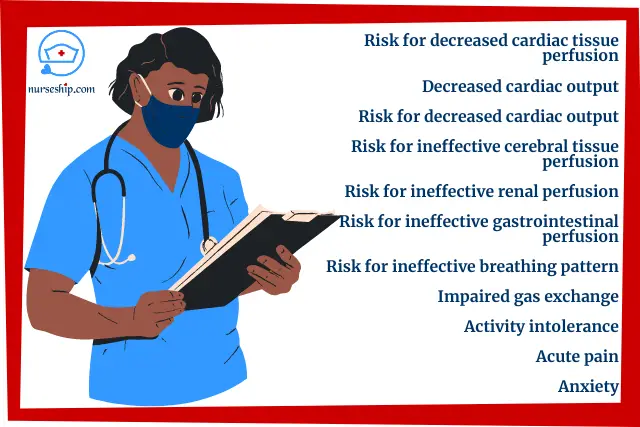
NANDA Nursing Diagnosis for Cardiac Surgeries
Acute pain
May be related to: mediastinal, leg, or arm incisions, myocardial infarction, angina, inflammation, tissue damage.
As evidenced by: verbalization of discomfort or pain, restlessness, irritability, increased heart rate, increased blood pressure
Decreased cardiac output
Risk for decreased cardiac output
May be related to: myocardial depression, dysrhythmias, electrolyte imbalances, hypovolemia, hypervolemia, myocardial infarction, coronary artery spasm, vasoconstriction, impaired contractility, alteration in preload, alteration in afterload, hypoperfusion, micro-emboli, hypoxia, damaged myocardium.
As evidenced by: elevated blood pressure, elevated mean arterial pressure greater than 120 mmHg, elevated systemic vascular resistance greater than 1400 dyne-seconds/cm5, cardiac output less than 5 L/min or cardiac index less than 2.7 L/min/m2, increased heart rate more than 110, cold, pale extremities, absent or decreased peripheral pulses, ECG changes, hypotension, S3 or S4 gallops, decreased urinary output, diaphoresis, orthopnea, dyspnea, crackle, jugular vein distention, edema, chest pain.
Risk for ineffective breathing pattern
Impaired gas exchange
May be related to: inadequate ventilation, ventilation/perfusion mismatching, abnormal ABGs, pain, blood loss, atelectasis, pneumothorax, hemothorax, increased pulmonary vascular resistance, increased capillary permeability, chemical mediators, decrease in surfactant.
As evidenced by: dyspnea, increased heart rate, apnea, ventilation/perfusion mismatching, abnormal ABGs, pain, increased hemodynamic pressures, oxygen saturation less than 90%, adventitious breath sounds, hypoxia, hypoxemia.
Impaired skin integrity
May be related to: alteration in activity, surgical incisions, puncture wounds, drains.
As evidenced by: disruption of skin tissue, insertion sites.
Risk for injury
May be related to: pacemaker failure, hemothorax or pneumothorax after insertion, bleeding, lead migration, heart perforation.
As evidenced by: decreased cardiac output, hemorrhage, diaphoresis, hypotension, restlessness, dyspnea, cyanosis, chest pain, muscle twitching, hiccoughs, muffled heart sounds, jugular vein distention, pulsus paradoxus.
Risk for infection
May be related to: surgical incisions, puncture wounds, drains.
As evidenced by: disruption of skin tissue, insertion sites.
Impaired physical mobility
May be related to: pain, limb immobilization.
As evidenced by: inability to move as desired, imposed restrictions on activity, decreased muscle strength and coordination, limited range of motion.
Disturbed body image
May be related to: presence of scars/ wounds, loss of control of heart function, disease process.
As evidenced by: fear of rejection, fear of reaction from others, negative feelings about the body, refusal to participate in care, refusal to look at the wound.
Activity Intolerance
May be related to: generalized weakness, imbalance between oxygen supply and demand.
As evidenced by: Verbalization of fatigue or weakness, abnormal heart rate or BP in response to activity, exertional discomfort, shortness of breath, dyspnea
Ineffective coping
May be related to: Situational, multiple life changes, inadequate relaxation, inadequate support systems, unmet expectations, unrealistic perceptions, ineffective coping methods, gender differences in coping strategies.
As evidenced by: Verbalization of inability to cope or ask for help, destructive behavior toward self, insomnia, muscular tension, irritability, anxiety, emotional tension, depression.
Anxiety
May be related to: change in health status, fear of death, threat to body image, threat to role functioning, pain.
As evidenced by: restlessness, insomnia, anorexia, increased respiration, increased heart rate, increased blood pressure, difficulty concentrating, dry mouth, poor eye contact, decreased energy, irritability, crying, feelings of helplessness.
Knowledge deficit
May be related to: lack of understanding, lack of understanding of medical condition, lack of recall
As evidenced by: questions regarding problems, inadequate follow-up on instructions given, misconceptions, lack of improvement of the previous regimen, development of preventable complications.
Click here to see Part 1 of this series.
NANDA Nursing Diagnosis for Aortic Aneurysm
Risk for decreased cardiac tissue perfusion
Risk for ineffective renal perfusion
Risk for ineffective gastrointestinal perfusion
May be related to: arterial occlusion, aneurysm, dissecting aneurysm, or operative complications
As evidenced by: pulsating mass, bruits, thrills, abdominal pain, low back pain, nausea, vomiting, syncope, chest pain, cough, hoarseness, dysphagia, dyspnea, shortness of breath, pallor, loss of pulses, paresthesia, paralysis.
Acute pain
May be related to: pressure exerted on various structures by aneurysm, infringement on nerves, surgical procedures.
As evidenced by: pain in the abdomen, lower back, hips, scrotum, chest, shoulders, neck, and back; nausea, vomiting, increases in blood pressure, increased heart rate, facial grimacing, moaning, shortness of breath.
Risk for impaired skin integrity
Impaired skin integrity
May be related to: edema, bedrest, surgery, pressure, altered circulation and blood flow, altered metabolic states.
As evidenced by: skin surface disruptions, incisions, ulcerations, wounds that do not heal.
Activity intolerance
May be related to: generalized weakness, imbalance between oxygen supply and demand.
As evidenced by: Verbalization of fatigue or weakness, abnormal heart rate or BP in response to activity, exertional discomfort, shortness of breath, dyspnea.
Ineffective coping
May be related to: Situational crisis, inadequate relaxation, inadequate support systems, unmet expectations, unrealistic perceptions, ineffective coping methods, gender differences in coping strategies.
As evidenced by: Verbalization of inability to cope or ask for help, destructive behavior toward self, chronic fatigue or insomnia, muscular tension, chronic worry, irritability, anxiety, emotional tension, depression.
Anxiety
May be related to: change in health status, fear of death, threat to body image, threat to role functioning, pain.
As evidenced by: restlessness, insomnia, anorexia, increased respiration, increased heart rate, increased blood pressure, difficulty concentrating, dry mouth, poor eye contact, decreased energy, irritability, crying, feelings of helplessness.
Knowledge deficit
May be related to: lack of understanding, lack of understanding of medical condition, lack of recall
As evidenced by: questions regarding problems, inadequate follow-up on instructions given, misconceptions, lack of improvement of the previous regimen, development of preventable complications.
NANDA Nursing Diagnosis for Infective Endocarditis (IE)
Decreased cardiac output
Risk for decreased cardiac output
May be related to: complications with infected heart valves, potential for cardiac tamponade because of effusion, damaged myocardium, decreased contractility, dysrhythmias, conduction defects, alteration in preload, alteration in afterload, vasoconstriction, myocardial ischemia, ventricular hypertrophy
As evidenced by: decreased blood pressure, tachycardia, pulsus paradoxus greater than 10 mmHg, distended neck veins, increased central venous pressure, dysrhythmias, decreased QRS voltage or electrical alternans, diminished heart sounds, dyspnea, friction rub, cardiac output less than 5 L/min, cardiac index less than 2.5 L/min/m2, change in mental status, change or new cardiac murmur, arterial emboli, decreased urine output, cyanosis, cold clammy skin
Hyperthermia
May be related to: bacteremia, allergic vasculitis, arterial occlusion or infarction, abscess.
As evidenced by: body temperature greater than normal range, flushed warm skin, chills, increased heart rate, increased respiratory rate.
Risk for infection
May be related to: inhibition of antibodies due to immunological system action, inflammatory processes due to vegetation growth, predisposition to bacteremia, septic emboli, myocardial abscess, occlusion of arteries leading to necrosis of body systems, invasive procedures and lines, dental procedures, nosocomial infections, lack of recognition of infection, lack of prophylactic treatment, suprainfection.
Decreased cardiac tissue perfusion
Risk for decreased cardiac tissue perfusion
Risk for ineffective cerebral tissue perfusion
Ineffective cerebral tissue perfusion
Risk for ineffective renal perfusion
Ineffective renal perfusion
May be related to: history of recent dental procedures, implanted cardiovascular medical devices, chronic skin disorders and infections, burns, infectious diseases, history of previous valve surgeries or a heart transplant, calcium deposits in the mitral valve or in the aortic valve, congenital heart defects, history of endocarditis.
As evidenced by: Acute IE – elevated body temperature (102°–104°), chills, increased heart rate, fatigue, night sweats, aching joints and muscles, persistent cough, or swelling in the feet, legs or abdomen.
Chronic IE – fatigue, elevated body temperature (99°–101°), increased heart rate, weight loss, sweating, and anemia.
Also include – petechiae, arthritis, arthralgia, myalgias, decreased peripheral pulses, Janeway’s lesions, Roth‘s spots, Osler’s nodes, lower back pain, splinter hemorrhages to subungual areas, hematuria, oliguria, anuria, chest pain, shortness of breath, dyspnea, confusion, weakness, convulsions, coma, hemiplegia, aphasia, hemiparesis, cardiac tamponade, pericardial friction rub, murmur, dysrhythmias, conduction defects, cold clammy skin, cyanosis, mental status changes, hypotension, tachycardia, decreased urinary output, increased BUN.
Anxiety
May be related to: change in health status, fear of death, threat to body image, threat to role functioning, pain.
As evidenced by: restlessness, insomnia, anorexia, increased respiration, increased heart rate, increased blood pressure, difficulty concentrating, dry mouth, poor eye contact, decreased energy, irritability, crying, feelings of helplessness.
Knowledge deficit
May be related to: lack of understanding, lack of understanding of medical condition, lack of recall
As evidenced by: questions regarding problems, inadequate follow-up on instructions given, misconceptions, lack of improvement of the previous regimen, development of preventable complications.
Quick Links
3 Sample Nursing Care Plan for Hypoglycemia |NANDA nursing diagnoses |Interventions |Rationales
3 Sample Nursing Care Plans for UTI |NANDA nursing diagnoses |Interventions |Rationales
Sample Nursing Care Plan for Preeclampsia |scenario|NCP with rationales
3 Sample Nursing Care Plan for CHF [Congestive Heart Failure] (with rationales and case scenario)
Reference
Herdman, T. and Kamitsuru, S., 2018. NURSING DIAGNOSES: Definitions and Classifications 2018-2020. 11th ed. New York: Thieme.
Gulanick, M. and Myers, J., 2014. NURSING CARE PLANS: Diagnoses, Interventions, and Outcomes. 8th ed. Philadelphia: Elsevier/Mosby.
Comer, S. and Sagel, B., 1998. CRITICAL CARE NURSING CARE PLANS. Englewood, CO: Skidmore-Roth Publications.
Swearingen, P., 2016. ALL-IN-ONE CARE PLANNING RESOURCE. 4th ed. Philadelphia, PA: Elsevier/Mosby.

